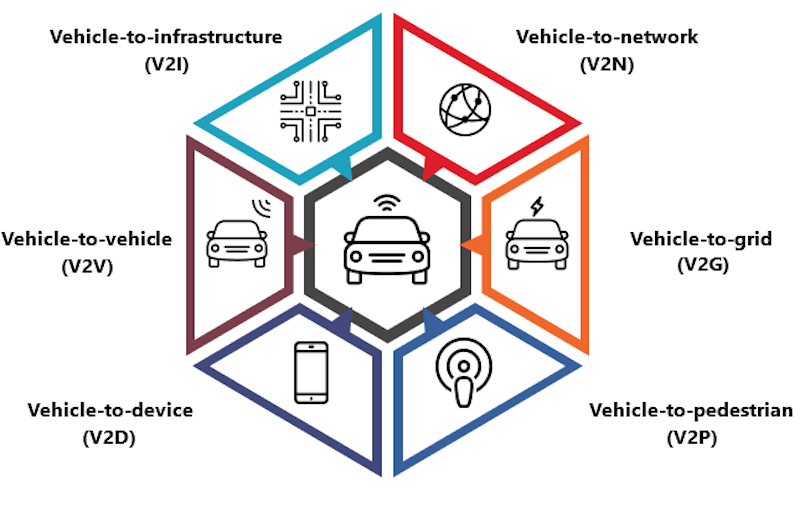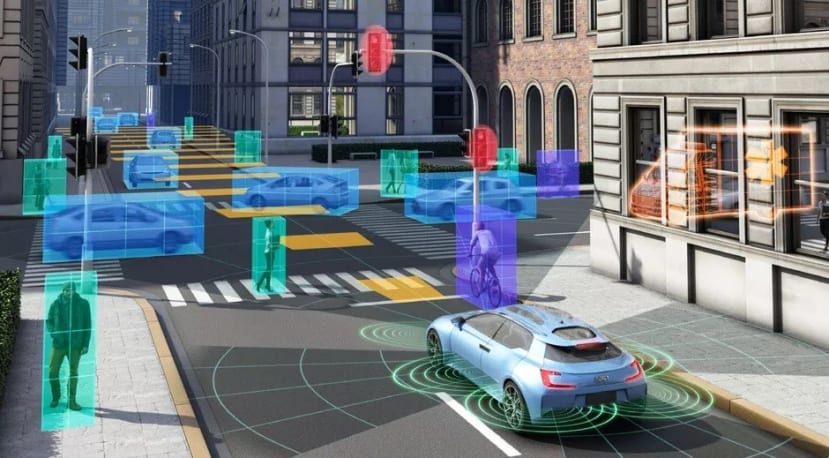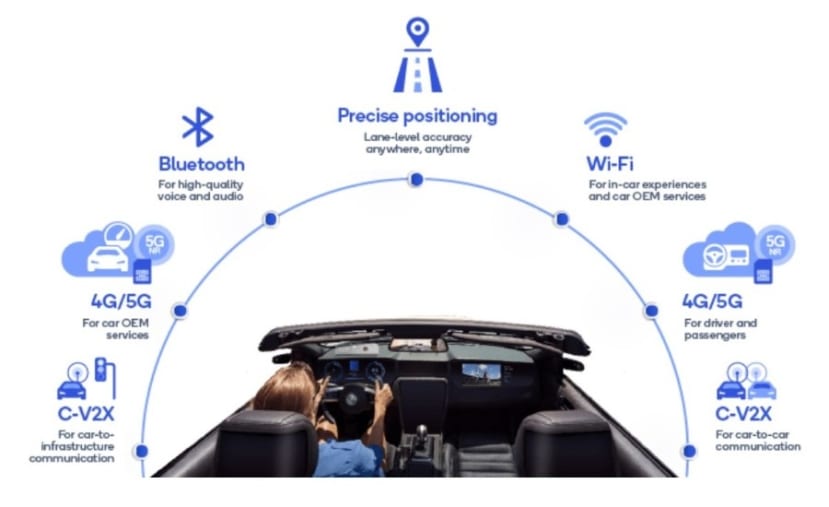Connecting Cars
Follow articleHow do you feel about this article? Help us to provide better content for you.
Thank you! Your feedback has been received.
There was a problem submitting your feedback, please try again later.
What do you think of this article?
Remember when the vehicle entertainment system was an AM radio and a cigarette lighter?
Those were the days. In the UK, vehicle safety mostly consisted of Shaw Taylor advising everyone to “Clunk-Click, every trip” in a bid to get people to voluntarily use those pesky seat belts and Darth Vader – in the guise of the Green Cross Man – telling children that he wouldn’t be there when they crossed the road so they ought to use the Green Cross Code.
The 12V electrical system that the radio and cigarette lighter ran off was adopted in the late 1950s to cope with higher ignition system voltages and the extra power needed to run more new features like the window demister.
Originally, ‘vehicle electricals’ was just the ignition circuitry but an ancillary branch to the (then) 6V system had allowed the 1912 Cadillac to roll off the production line with a radical new feature: an electric starter. All sorts of ancillaries were soon attached to the 6V power source, such as windscreen wipers, horns, turn signals, and lights. By 1930, 6V systems were standard pretty much everywhere.
Everyone knows how much vehicle electricals have changed since 12V systems were introduced, mostly through the inclusion of increasingly complex electronics like sensor arrays, driver assist (ADAS) and infotainment systems. It’s all becoming too much for our poor old 12V alternator but unless you happen to keep an eye on the automotive industry, one of the most disruptive changes for years is taking place under most people’s radar: the introduction of 48V vehicle electrical systems alongside legacy 12V systems.
The industry flirted with the idea of 42V systems in the early 2000s but the legislative pressure wasn’t high enough to overcome their concerns about the costs and engineering practicalities of implementing dual power systems. Things have changed since then. Not only has the electrical power demand continued to rise, but environmental concerns have also risen to the top of most legislative bodies’ agendas, so manufacturers have new regulations they all must comply with. The introduction of 48V systems helps car makers deal with both pressures.
How 48V Can Save the World
You may be wondering why settle on 48V? Other than being a nice multiple of 12V (i.e. four trusty old 12V batteries in series), it also means any peaks are below 60V which is the point where (much more expensive) high voltage cabling and connectors are required to meet more stringent regulation.
A wire of a given gauge can carry four times the power at 48V than at 12V (remember P = VI) so a cable limited by a 20A fuse can carry 240W at 12V and 960W at 48V. That is a great power boost that will allow a smorgasbord of extra electronics to be packed into cars, but this isn’t the manufacturer’s main focus. The aim is to augment the combustion engine: reducing fuel consumption while, at the same time, increasing the responsiveness of the vehicle.
How is that possible?
The first step is to take all auxiliary functions that are currently directly driven by the engine (e.g. power steering, water pumps, brake vacuum pumps, air conditioning) and use electric motors instead. These functions can then be delivered only as and when they are required. An example is environmental control: in normal use, the air conditioning compressor is off far more than it is engaged, so a separate electric motor means that you are not continually tapping a couple of horsepower from the engine for the compressor and you can still run cooling cycles when the engine is in stop/start mode. An engine freed of these loads is immediately going to be more efficient and responsive.
The next thing that 48V makes possible is replacing the traditional starter with a much more substantial motor generator unit (MGU). This unit acts as a generator while braking to charge the vehicle battery. When you come to a stop, the engine will cut out after a couple of seconds. When you want to go again, the motor generator will restart the engine and add additional low-end torque to boost acceleration. With a little tweaking, this system can be used for low-speed, emission-free movement through enclosed parking lots or low-emission zones in cities.

Another vision for using electric power to enhance the engine power curve is one high-end manufacturers, like Lamborghini, have been looking at: using supercapacitors to reduce or even eliminate the weight of lithium-ion battery packs while boosting the speed at which power can be delivered.
Add-ons that 48V systems make possible include the electric supercharger (or e-charger). Rather than being driven by the engine like a standard supercharger (or exhaust gasses like a turbocharger), the e-charger uses an electric motor to drive an impeller giving a 4-cylinder car the performance of a V6 without turbo-lag or extra fuel use from continually being driven by the engine.
An example that is already in use is the triple-charging system used on the Bentley Bentayga (and the Audi SQ7, which uses the same engine) where the engine gets a boost at low revs from the near-instantly reacting electric supercharger which also primes the first of two twin-scroll turbochargers. This first turbo amplifies midrange thrust, then a second twin-scroll turbo provides extra shove at mid to high revs when the e-booster is dormant. The Audi Electric supercharger has a 7kW motor, which spins up from idle to 70,000rpm in only 250 milliseconds. The result is pretty stunning: maximum torque of 664lb ft at only 1000rpm!
V2X
All of the new systems are packed with sensors and control networks that interconnect within the vehicle, but networking is set to expand well beyond the car’s body shell. The car industry and regulators have, of course, already got some acronyms for all the proposals. V2X is the umbrella term for vehicle to everything-that-might-affect-the-vehicle communications.
Then there are the subsystem acronyms:
V2V is vehicle to vehicle communications. This is where cars, trucks, motorbikes, etc. communicate with each other directly over short ranges to share information about their position, speed and intensions to avoid accidents and collaborate on traffic management.
V2I is vehicle to infrastructure, where vehicles connect with road infrastructures like traffic lights, smart signs, and other road management systems.
V2D and V2P are vehicle to device and vehicle to pedestrian and somewhat overlap in the idea of communicating with smartphones so that in the case of V2P, a pedestrian’s presence and desire to cross the road is noted by nearby vehicles and infrastructure. V2D uses smartphones to provide services directly between a car and device, like keyless entry and starting. This kind of service would allow for car sharing.
V2N is vehicle to network communication. This would permit infotainments streams and other network-reliant, in-vehicle services.
V2G is a little more in the realms of wishful thinking at present and stands for vehicle to grid. The idea is that future electric vehicles may become part of an intelligent energy distribution grid that will mitigate massive demand surges by taking (and sourcing) energy in collaboration with the grid system, thus making better (and more even) use of the available capacity.
All of these communications require a reliable, low latency radio system to exchange messages, regardless of the environmental conditions, where vehicles can be travelling at combined closing speeds of 500kmh or more.
Right now, there are two competing standards vying for V2X dominance.
IEEE 802.11p
The incumbent standard is based on the IEEE’s WLAN-based wireless access for vehicular environments (or WAVE) program. This is essentially a spin-off of Wi-Fi and was finalised as IEEE 802.11p in 2012 to be the radio protocol that underpins the V2X standard called Dedicated Short Range Communication or DSRC in the United States and ITS-G5 in Europe.
V2X using 802.11p aids drivers already equipped with line-of-sight sensors like cameras, radar and lidar with beyond-visual-range V2V and V2I information like collision warnings, reduced speed traffic alerts, vacant car parking spaces, and toll payments.
Functionally, 802.11p provides low latency (~2ms), short-range (< 1km) and high reliability. It has been widely trialled and in tests by the US Department of Transportation, its performance was found to be immune to extreme weather conditions like heavy rain, fog, and snow.
802.11p uses onboard units (OBUs) and roadside units (RSUs) for connections and the chipsets for these are available from a number of silicon vendors including NXP, Renesas Electronics, Marvell and Redpine Signals.
There has been considerable interest and investment in the standard. The US National Highway Traffic Safety Administration (NHTSA) and International Standards Organisation (ISO) had specified DSRC as the standard for V2V. In April 2019 the EU backed DRSC as the base standard for V2V and V2I with LTE/5G for accessing V2N (i.e. cloud) services.
In 2016, Toyota began equipping some Japanese models with DSRC V2X. They were followed by GM (on Cadillac models) in the US and Volkswagen (on the Golf) in Europe. These car makers have become more tentative with their development plans though, due to the emergence of a vocal and disruptive challenger.
Cellular V2X
“Hold my beer” said the mobile telecoms industry, on seeing DSRC V2X proposals. They think 4G LTE and the eventual 5G network is a much better bet and have been very vocal about it with regulators. The main proponents are the 5G Automotive Association, which has many heavyweight silicon and car manufacturers as members, and chipmaker Qualcomm, who have a chipset for use in trials.
The key advantage that C-V2X has is that it can cover pretty much all of the V2X scope within the way it operates. Direct communication between a vehicle and other devices (V2V, V2I, and probably V2P) uses the LTE PC5 interface which was originally defined (on the unlicensed 5.9GHz band) to allow device to device communications when LTE infrastructure (i.e. base stations) was unavailable, such as after a natural disaster. These days it is mostly used to allow smartphones to talk to wearables like smartwatches. This functionality aligns pretty closely with what is available with 802.11p, which also uses the 5.9GHz band.
C-V2X can also use the standard Uu interface to connect to a base station and therefore the rest of the cellular network. This could allow for infotainment streaming and messages about longer-range road hazards or traffic, which would not be adversely affected by system latency. However, it is worth pointing out that just as IEEE 802.11p would require a separate radio chipset to make ad-hoc connections to base stations, C-V2X would also need two radios to simultaneously use the P5 interface and a Uu interface to the network.
When the EU Commission put forward its legislation favouring 802.11p there was a flurry of lobbying from the GSMA and ETNO arguing that 802.11p could not be integrated into 4G/5G networks and was not futureproof. They also hinted that the rollout of 5G could be affected in Europe.
The pressure has meant that the EU commission is redrafting more open legislation for a new vote and the FCC is the US initiated a second proceeding to explore the possibility of reallocating some 5.9GHz band channels away from DSRC to C-V2X.
Right now, 802.11p is the only proven technology available and it doesn’t rely on a potentially expensive subscription or data service plan. That is a big plus in regions like Japan, Europe, and the US.
However, China has very clearly nailed its colours to the mast as a C-V2X supporter with the National Development and Reform Commission laying out a roadmap that includes 90% LTE-V2X coverage for big cities and Highways in 2020. Ford in China has plans to deploy C-V2X equipped cars there by 2021. These facts may prove influential.
How the coin eventually falls on adopting V2X will probably depend on whose lobby group is the best at influencing the regulators, rather than the technology. Either way, it is an interesting time for automotive electronics.
Final Thoughts
The engineering challenges of 48V systems and V2X hinge around achieving reliable and consistent communications within and between vehicles, infrastructure, and the network. Issues include hostile environmental conditions, a complex and often noisy RF environment, and EMI. It is easy to forget the impact that simple, physical connectors have in all of this.
They can make the difference between reliable operation and desperately annoying intermittent failures. Suppliers like TE Connectivity have a long history in the automotive industry, supplying proven connection technology. If your projects have to survive in a hostile environment, automotive-grade parts are often the most cost-effective way to meet those requirements.







